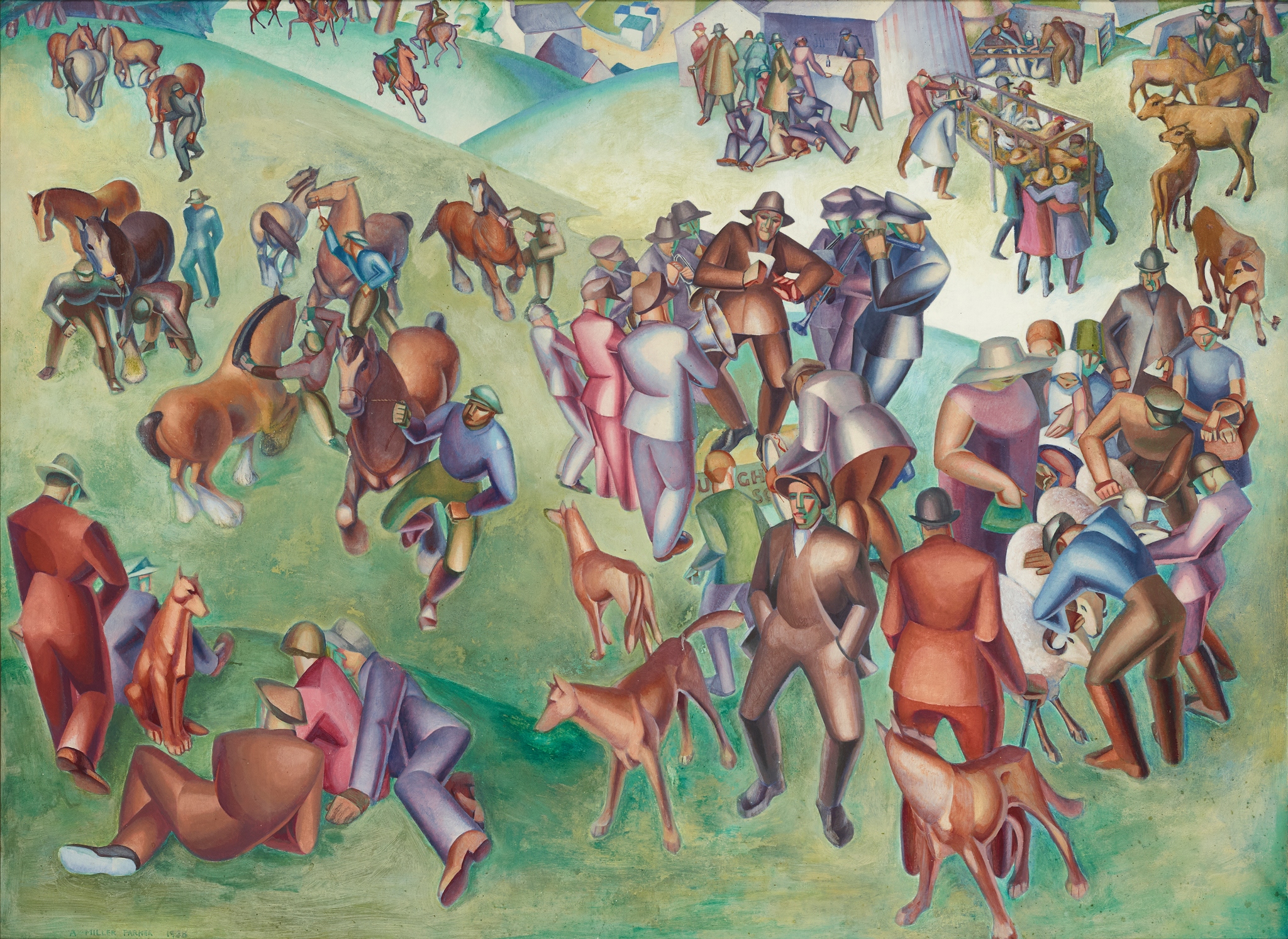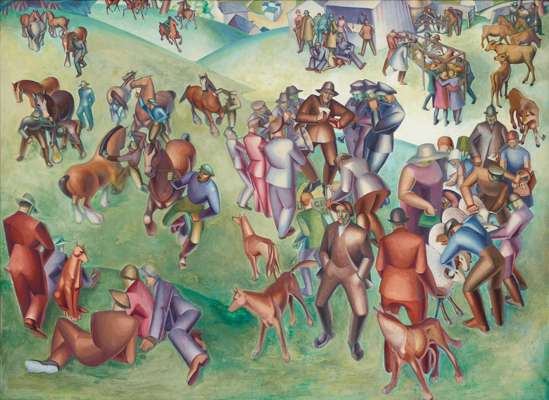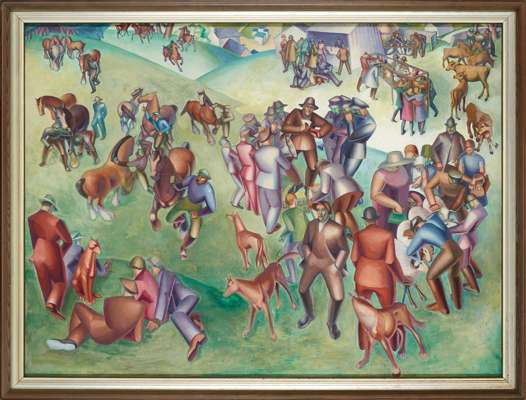
Lot 165

AGNES MILLER PARKER (SCOTTISH 1895-1980) §
THE HORSE FAIR, 1928








Scottish Paintings & Sculpture
Auction: Evening Sale | Lots 109 to 207 | Thursday 04 December 2025 from 6pm
Description
Signed, tempera on canvas
Dimensions
81cm x 109cm (31.75in x 43in)
Provenance
Acquired from the Artist by Naomi Mitchison (1897-1999) and thence by descent to the present owners
On loan to the National Galleries of Scotland, Edinburgh 2016 - 2025
Exhibited:
Scottish National Gallery of Modern Art, Edinburgh, Modern Scottish Women: Painters and Sculptors 1885-1965, 7 November 2015 – 26 June 2016
Scottish National Gallery of Modern Art, Edinburgh, A New Era: Scottish Modern Art 1900-1950, 2 December 2017 – 10 June 2019, illustrated in colour p.100
Scottish National Gallery, Edinburgh, A Point in Time: The 1920s, September 2023 – July 2025
Literature:
Louise Newton, ‘Inspirational Women of Scotland: Alice Strang and her Quest for Scotland’s ‘Lost’ Artists', The Caledonian, Summer 2017, illustrated in colour p.19.
Alice Strang, ‘My Favourite Painting’, Country Life, 15 June 2020, illustrated in colour p.56
"The Horse Fair's rarity and originality meant it soared to a world record £176,600. It was great to see international interest in Scottish art continue to go from strength to strength." - Alice Strang, Senior Scottish Art Specialist. Read more here.
Footnote
The Horse Fair of 1928 by Agnes Miller Parker is a rare and remarkable statement of British modernism, created by a Scottish artist in London between the wars. Moreover, it is one of what is believed to be a handful of such works by her, created during an especially productive period in the late 1920s in which she explored Vorticism, Cubism and their offshoots to create ‘original, complex and ambitious paintings.’ (Alice Strang, ‘From Annand to Zinkeisen: Forty-Five Scottish Women Painters and Sculptors’, Modern Scottish Women: Painters & Sculptors 1885-1965, National Galleries of Scotland, Edinburgh, p.21). The Horse Fair was acquired from the artist by her friend, the Scottish writer and social activist Naomi Mitchison (1897-1999), in whose family it has remained ever since.
Miller Parker was born in Irvine and trained in Painting and Drawing at Glasgow School of Art, where she met fellow student William McCance (1894-1970). They married in 1918 and moved to London two years later. They lived with the avant-garde artist William Roberts (1895-1980) in Earl’s Court before moving to Chiswick, near Hammersmith, where they became friends with Mitchison (née Haldane) and her husband Gilbert Richard ‘Dick’ Mitchison (1890–1970). Other friends included the artists Blair Hughes-Stanton (1902-81) and his wife Gertude Hermes (1901-83). As art critic of The Spectator from 1923 until 1926, McCance kept abreast of the modern art movement and he and Miller Parker came into a contact with numerous artists and writers.
Mitchison gleefully recalled this period in their lives, writing in 1979:
“Hammersmith was presumably thought in other circles to be very avant-garde and we had a good share of love and hate affairs, rushing in and out of one another’s lives…There was always argument, admiration, dressing up and parties…Here was Robert Graves, who might be delightful or might bite…Here was Dylan Thomas holding forth, never sober. Here sometimes was Augustus John…who…had a glass of beer in each hand.” (Naomi Mitchison, You May Well Ask: A Memoir 1920-1940, Victor Gollancz Ltd, London, 1979, pp.80-81)
In 1925, the McCances were described as ‘that clever couple from Scotland who believe in cubist methods’, whilst Hugh MacDiarmid declared that ‘Mr and Mrs McCance’ were ‘unquestionably the most promising phenomena of contemporary Scotland in regard to art.’ (Daily Chronicle, 30 November 1925, cited in Hal Bishop, ‘Parker, Agnes Miller (1895-1980)’, Oxford Dictionary of National Biography, Oxford, 2004, accessed 4 November 2025 and Christopher Murray Grieve, ‘William and Agnes McCance’, Scottish Educational Journal, November 1925, see Alan Riach (ed.), Contemporary Scottish Studies, Carcanet Press Ltd, Manchester, 1995, p.167).
However, Mitchison disparagingly described McCance and Miller Parker’s relationship thus: ‘Mac himself was something of a phoney, demanding to be taken as a D. H. Lawrence-type genius; his wife, who in fact provided the family income and was a far better artist, was forced into practising mousemanship.’ (Naomi Mitchison, op.cit., p. 79).
Mitchison went on to describe the cottage that she and Dick, the McCances and Margery and Dominick Spring Rice jointly owned on Bledlow Ridge called Pounds Scots, explaining:
“It really was a cottage, barely modernised, with interesting sloping ceilings on which the taller inhabitants bumped their heads, a wood fire constantly needing to be fed, a steep and narrow staircase and quite a squash when we were all there…There were of course no servants; it was assumed that the three women would do all the work whilst the men went for bracing intellectual walks. After a few years, that came to an end.” (Naomi Mitchison, ibid., pp. 79-80)
She also based the character of the engraver Phoebe Fraser on Miller Parker in her novel We Have Been Warned (Constable, London, 1935).
In 1928, the year in which she painted The Horse Fair, Miller Parker, McCance, Hughes-Stanton and Hermes held a group exhibition at St George’s Gallery in London. The Kilmarnock Herald and North Ayrshire Gazette declared:
“Two…Scottish artists, William McCance and Agnes Miller Parker (Mrs McCance) have been exhibiting in London and have favourably impressed the leading critics…Both are extraordinarily significant artists, immersed in consideration of abstract form, and at the very opposite pole from the pictorial platitudinising which is generally accepted as synonymous with Art in Scotland. Both, too, are keenly conscious of their Scottish nationality and that, together with a thorough knowledge of modern technique, is what Scotland needs most. Were they to repeat their exhibition in Glasgow it might well form the starting point for a new Scottish school.” (12 April 1928)
Two years later, Miller Parker participated in the first and only exhibition of The Neo Society, at Godfrey Phillips Galleries in London. She showed five paintings, three of which, like The Horse Fair, were realised in tempera including The Uncivilised Cat, now in the Fleming-Wyfold Art Foundation collection (acc.no.3259).
At just over a metre in width, The Horse Fair is perhaps Miller Parker’s most ambitious painting. Writing with it in mind, Alice Strang has explained:
“The work that McCance and Miller Parker produced during this decade shows an unusually imaginative and vigorous response to the evolving Cubist and Surrealist movements…Miller Parker’s…part-simplification, part-mechanisation of form, realised through the acute observation and skilful orchestration of human and animal interaction is remarkable.” (Alice Strang, ‘A New Era: An Introduction’, A New Era: Scottish Modern Art 1900-1950, National Galleries of Scotland, Edinburgh, 2017, p.10).
Writing about The Horse Fair in Country Life, John McEwen described Miller Parker’s embracing of the:
“…mechanical vision inspired by pre-First World War Italian Futurism and its London off-shoot Vorticism. Miller Parker’s crowd scene shows humans as tubular shaped with hands like implements…indebted to the crowd scenes of William Roberts who had been a signatory of the Vorticist Manifesto…scrutiny reveals her picture to be about more than trading horses. The diagonal composition descends from the distant bare-backed riders (top left) to two foreground men and their dogs (bottom right). The fair extends over three hills above a village (centre top). To the right of the glimpsed village are a beer tent, duck and chicken pens and ambling calves. Below them is a…cluster of people around some ewes and rams, among them a formidable woman in a summer hat. The most energetic group is the cart horses led by tugging handlers. That they contradict the scale of the adjacent groups emphasises their dynamism, as does the robotic exaggeration of their actions.” (‘John McEwen comments on The Horse Fair’, Country Life, 15 June 2020, p.56)
In 1930, the McCances and the Hughes-Stantons moved to Wales to work at the Gregynog Press. Miller Parker’s reputation as an engraver and wood illustrator came to overshadow that of her as a painter. She and McCance separated in 1955 and she returned to Glasgow. Following their divorce in 1963, she moved to Arran before her death in Greenock in 1980.
The Horse Fair was included in the landmark exhibitions Modern Scottish Women: Painters & Sculptors 1885-1965 of 2015 to 2016 and A New Era: Scottish Modern Art 1900-1950 of 2017 to 2018. It was included in the Scottish National Gallery’s collection display A Point in Time: The 1920s when a suite of new galleries dedicated to Scottish art opened after a major re-development project in 2023. The Horse Fair was on long-loan to the National Galleries of Scotland between 2016 and 2025.








